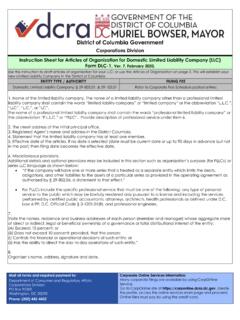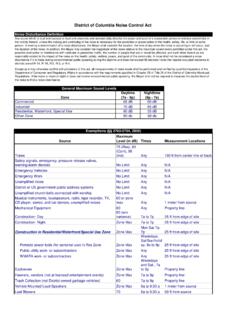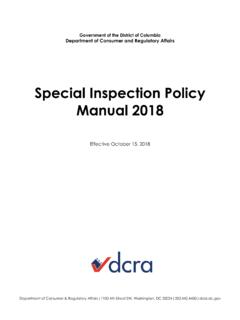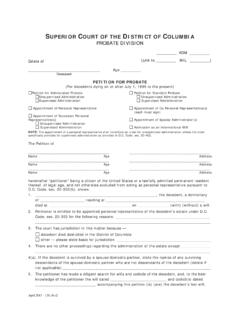Transcription of District of Columbia Energy Conservation Code
1 2017 Energy Conservation CodeDistrict of Columbia2017 Energy Conservation CodeDistrict of Columbia2017 District of Columbia Energy Conservation CodeFirst Printing: September 2020 COPYRIGHT 2014 International Code Council, Inc. (for 2015 International Energy Conservation Code )COPYRIGHT 2020 Government of the District of Columbia (for new text)ALL RIGHTS RESERVED. This 2017 District of Columbia Energy Conservation Code contains substantial copyrighted materi-als from the 2015 International Energy Conservation Code , third printing, which is a copyrighted work owned by the Interna-tional Code Council, Inc. ( ICC ). Without advance written permission from the ICC, no part of this book may be reproduced,distributed or transmitted in any form or by any means, including, without limitation, electronic, optical or mechanical means (byway of example, and not limitation, photocopying, or recording by or in an information storage retrieval system).
2 For informationon use rights and permissions, please contact: ICC Publications, 4051 Flossmoor Road, Country Club Hills, IL 60478. Phone 1-888-ICC-SAFE (422-7233).The 2017 District of Columbia Energy Conservation Code contains substantial copyrighted material from the ANSI/ASHRAE/IESS tandard 2013, which is a copyrighted work owned by ASHRAE. Without advance written permission from the copyrightowner, no part of this book may be reproduced, distributed or transmitted in any form or by any means, including, without limita-tion, electronic, optical or mechanical means (by way of example, and not limitation, photocopying, or recording by or in an infor-mation storage retrieval system). For information on permission to copy material exceeding fair use, please contact: ASHRAEP ublications, 1791 Tullie NE, Atlanta, GA 30329. ASHRAE has not investigated nor participated in the creation of this 2017 District of Columbia Energy Conservation Code,which contains substantial material from ANSI/ASHRAE/IES Standard 2013 and ASHRAE expressly disclaims any duty toinvestigate any product, service, process, procedure, design, or the like that may be described herein.
3 The appearance of any tech-nical data or editorial material in this publication does not constitute endorsement, warranty, or guaranty by ASHRAE of anyproduct, service, process, procedure, design, or the like. ASHRAE does not warrant that the information in this publication is freeof errors, and ASHRAE does not necessarily agree with any statement or opinion in this publication. The entire risk of the use ofany information in this publication is assumed by the : International Code Council, the International Code Council logo, ICC, the ICC logo, InternationalEnergy Conservation Code, IECC and other names and trademarks appearing in this book are registered trademarks of theInternational Code Council, Inc., and/or its licensors (as applicable), and may not be used without IN THE USA2017 District OF Columbia Energy Conservation CODEiiiPREFACEB ackgroundThe 2017 District of Columbia Construction Codes, effective May 29, 2020, consist of the following12 codes: 2017 District of Columbia Building Code [2015 edition of the International Building Code published by the International Code Council (ICC) as amended by the District of ColumbiaConstruction Codes Supplement of 2017 (DCMR 12A, Building Code Supplement)].
4 1 2017 District of Columbia Residential Code [2015 edition of the International ResidentialCode published by the ICC as amended by the District of Columbia Construction CodesSupplement of 2017 (DCMR 12B, Residential Code Supplement)]. 2017 District of Columbia Electrical [2014 edition of the National Electrical Code publishedby the National Fire Protection Association (NFPA) as amended by the District of ColumbiaConstruction Codes Supplement of 2017 (DCMR 12C, Electrical Code Supplement)]. 2017 District of Columbia Fuel Gas Code [2015 edition of the International Fuel Gas Code published by the ICC as amended by the District of Columbia Construction Codes Supple-ment of 2017 (DCMR 12D, Fuel Gas Code Supplement)]. 2017 District of Columbia Mechanical Code [2015 edition of the International MechanicalCode published by the ICC as amended by the District of Columbia Construction CodesSupplement of 2017 (DCMR 12E, Mechanical Code Supplement)].
5 2017 District of Columbia Plumbing Code [2015 edition of the International PlumbingCode published by the ICC as amended by the District of Columbia Construction CodesSupplement of 2017 (DCMR 12F, Plumbing Code Supplement)]. 2017 District of Columbia Property Maintenance Code [2015 edition of the InternationalProperty Maintenance Code published by the ICC as amended by the District of ColumbiaConstruction Codes Supplement of 2017 (DCMR 12G, Property Maintenance Code Supple-ment)]. 2017 District of Columbia Fire Code [2015 edition of the International Fire Code publishedby the ICC as amended by the District of Columbia Construction Codes Supplement of 2017(DCMR 12H, Fire Code Supplement)]. 2017 District of Columbia Energy Conservation Code [2013 edition of the Energy Standardfor Buildings Except Low-Rise Residential Buildings (ANSI/ASHRAE/IES ) pub-lished by ASHRAE (formerly known as the American Society of Heating, Refrigeration andAir-Conditioning Engineers, Inc.)]
6 And the 2015 edition of the International Energy Conser-vation Code Residential Provisions published by the ICC as amended by the District ofColumbia Construction Codes Supplement of 2017 (DCMR 12I, Energy Conservation CodeSupplement)]. 2017 District of Columbia Existing Building Code [2015 edition of the International ExistingBuilding Code published by the ICC as amended by the District of Columbia ConstructionCodes Supplement of 2017 (DCMR 12J, Existing Building Code Supplement)]. 2017 District of Columbia Green Construction Code [2012 edition of the International GreenConstruction Code published by the ICC as amended by the District of Columbia Construc-tion Codes Supplement of 2017 (DCMR 12K, Green Construction Code Supplement)]. 2017 District of Columbia Swimming Pool and Spa Code [2015 edition of the InternationalSwimming Pool and Spa Code published by the ICC as amended by the District of Colum-bia Construction Codes Supplement of 2017, 12 DCMR L, Swimming Pool and Spa Code Sup-plement)].
7 1. The District of Columbia Municipal Regulations (DCMR) is the official compilation of rules and regulations issued by government agencies and the Council and is available online at: District OF Columbia Energy Conservation CODEThe ICC, ASHRAE and NFPA Codes have been extensively amended by the District of Columbia toaddress specific District of Columbia policies and statutes, and unique characteristics of the Districtof ICC and NFPA Codes provide a comprehensive, coordinated set of building safety and firecodes that have been adopted by 50 states and the District of Columbia at the jurisdictional or statelevel. The ICC s consensus-based code development process involves a broad range of stakeholders,including construction industry representatives and code regulators, to ensure that the modelcodes incorporate the latest technical advancements, while addressing industry and regulatory con-cerns.
8 The ICC Codes also provide helpful resources, such as interpretive commentary and history ofamendments, which provide a basis for interpreting the District of Columbia Construction 1791, President George Washington issued the first building guidelines in Washington, guidelines largely emphasized aesthetics in order to ensure that new buildings comple-mented Pierre L Enfant s plan for the city. By 1872, during a period of rapid change and expansionafter the Civil War, the District of Columbia adopted the first comprehensive set of building regula-tions focusing on health and safety concerns. The 1872 regulations, introduced by the Congressio-nally established Board of Public Works, required building permits for the first time. Nineteenthcentury building regulation also included The Height of Buildings Act, enacted by Congress in 1899to address safety concerns about the use of steel framing.
9 The greater building heights achieved bysteel-framed structures raised concerns about the city s ability to extinguish fires, and the possibil-ity of structural with the growing national trend towards nationally-recognized model building codes,in 1986 the District of Columbia adopted five of the 1984 codes published by the Building OfficialsCode Administrators (BOCA) International along with model codes published by the Council ofAmerican Building Officials and the National Fire Protection Association. In 1994, after BOCA com-bined with other model code groups to establish the ICC with a common goal of developing a singlecoordinated set of national model building codes, the District of Columbia began transitioning tothe ICC s International Codes (I-Codes ). Beginning in 1999 the District of Columbia adopted the1996 International Mechanical Code and 1995 International Plumbing Code, and completed thetransition to the I-Codes in 2003, when nine of the 2000 edition of the I-Codes were the 2008 update of the District of Columbia Construction Codes, and in recognition ofthe need for a more robust, responsive and ongoing code development process in the District ofColumbia, a new Construction Codes Coordinating Board (CCCB) was created by Mayoral Order inMarch 2009 to replace the Building Code Advisory The members of the CCCB areappointed by the Mayor (except for one member appointed by the DC Council)
10 And represent vari-ous stakeholders in the code development process, including architects, engineers, governmentregulators, representatives of the construction and housing industries and city residents. The CCCBis supported administratively by the District of Columbia Department of Consumer and RegulatoryAffairs (DCRA) and has been delegated authority by the Mayor to issue rules to amend the Construc-tion Codes and to adopt the model codes pursuant to procedures set forth in the DC Official Code, 6-1409. In considering adoption of the ICC, ASHRAE and NFPA codes and reviewing local code change pro-posals, the CCCB considers relevant criteria and policies including: Minimum performance standards and requirements for construction and constructionmaterials, consistent with nationally accepted standards of engineering, fire, and lifesafety. Unique District of Columbia characteristics, policies or statutes.









